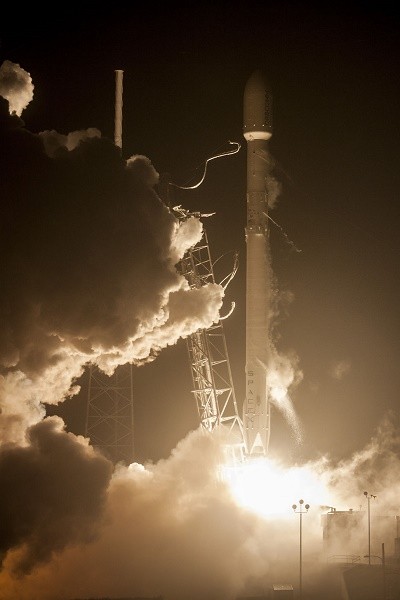By Ana Verayo, | March 02, 2016

Falcon 9
On its fourth consecutive attempt to launch a satellite and execute another vertical landing on a droneship, SpaceX moves its next launch to Thursday evening from the Air Force Station 1 at Cape Canaveral, Florida. This fourth attempt was scrubbed due to bad weather and winds.
Like Us on Facebook
The last three launch launch attempts for the new Falcon 9 rocket had later launch windows, where this fourth launch also had an earlier window beginning from 6:35 P.M. and ending on 8:05 P.M. SpaceX says that this earlier schedule will be an advantage for the launch to avoid upper level winds during the launch window, but bad weather prevailed with wind shears in high altitude.
The mission team will be observing and looking out for possible thick layers of clouds including cumulus clouds. However, according to the 45th Weather Squadron's launch forecast, there will be an 80 percent chance of good weather in the area of Launch Complex 40.
SpaceX team will now move the next launch schedule to Thursday which is also predicted to have an 80 percent chance of good weather according to the 45th Weather Squadron.
The third launch attempt was scrubbed last Sunday, as SpaceX suddenly called off the communications satellite with a few remaining seconds before lifting off. It was later revealed that a wayward boat entered the launch zone's restricted zone.
SpaceX CEO Elon Musk said on Twitter that the computers are programmed to automatically shut down during a low thrust detection, as Falcon 9 rocket's nine engines were immediately shut down. Musk tweeted, launch aborted on low thrust alarm, also due to rising oxygen temperatures after waiting for hold on boat, as helium bubble triggered the alarm.
Before last Sunday's scrubbed launch, last week's attempts were cancelled due to propellant temperature issues, as the liquid oxygen were not chilled to a freezing point. SpaceX says that the new version of the Falcon 9 rocket requires a denser form of liquid oxygen to launch the SES-9 satellite, weighing 11,600 pounds.
If the satellite launch is proven successful on Thursday, SpaceX will try to do vertical landing of its Falcon 9 rocket from 400 miles off the Florida coast, landing on a drone ship in the Atlantic ocean. SpaceX also aims to reuse its rockets to slash expensive costs of space launches, where an ocean landing can save more fuel and more resources.
-
Use of Coronavirus Pandemic Drones Raises Privacy Concerns: Drones Spread Fear, Local Officials Say

-
Coronavirus Hampers The Delivery Of Lockheed Martin F-35 Stealth Fighters For 2020

-
Instagram Speeds Up Plans to Add Account Memorialization Feature Due to COVID-19 Deaths

-
NASA: Perseverance Plans to Bring 'Mars Rock' to Earth in 2031

-
600 Dead And 3,000 In The Hospital as Iranians Believed Drinking High-Concentrations of Alcohol Can Cure The Coronavirus

-
600 Dead And 3,000 In The Hospital as Iranians Believed Drinking High-Concentrations of Alcohol Can Cure The Coronavirus

-
COVID-19: Doctors, Nurses Use Virtual Reality to Learn New Skills in Treating Coronavirus Patients







